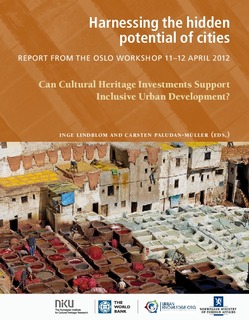| dc.contributor.editor | Lindblom, Inge | |
| dc.contributor.editor | Paludan-Müller, Carsten | |
| dc.date.accessioned | 2018-10-11T12:46:12Z | |
| dc.date.available | 2018-10-11T12:46:12Z | |
| dc.date.issued | 2012 | |
| dc.identifier.isbn | 978-82-8101-120-5 | |
| dc.identifier.issn | 1503-4909 | |
| dc.identifier.uri | http://hdl.handle.net/11250/2567671 | |
| dc.description.abstract | This report presents both the written contributions to and discussions from the Oslo Workshop on «Harnessing the Hidden Potential of Cities», held on 11‒12 April 2012. This event came about thanks to the Norwegian government’s participation in The Multi-Donor Trust Fund for Cultural Heritage and Sustainable Development (MDTF) managed by the World Bank.
The aim of this report is to share some of the knowledge and insights that emerged from the workshop with a wider audience. The papers published in the report could prove useful as a reference for future projects to harness cultural heritage for the benefit of the urban poor.
The workshop was organized as a plenary session with keynote speeches, followed by four parallel work sessions, and a final plenary session including panel discussions. The Oslo Workshop focused on cultural heritage in urban planning for development and sustainable growth and how best to work on upgrading slums in historic city centres. An important related topic was «how to work with cultural heritage in places where history is likely to be part of the theme of conflict».
This report introduces a set of success indicators for development efforts working towards slum upgrading, poverty reduction and cultural heritage management in city development projects in general.
Some general recommendations are given: we must undertake more projects in the real world and then bring learning from them back to the network which the workshop has generated. New projects have to work within measurable economic and social parameters, parameters defined and recognised by those living in the social worlds and places where the development programmes take place. We must make people our focus, and help them take possession of their heritage as an asset for a better future. | nb_NO |
| dc.description.sponsorship | The Norwegian Ministry of Foreign Affairs, The World Bank, NIKU | nb_NO |
| dc.language.iso | eng | nb_NO |
| dc.publisher | Norsk institutt for kulturminneforskning | nb_NO |
| dc.relation.ispartofseries | NIKU Tema;43 | |
| dc.rights | Attribution-NonCommercial-NoDerivatives 4.0 Internasjonal | * |
| dc.rights.uri | http://creativecommons.org/licenses/by-nc-nd/4.0/deed.no | * |
| dc.subject | urbanity | nb_NO |
| dc.subject | development | nb_NO |
| dc.subject | cultural heritage | nb_NO |
| dc.subject | urban planning | nb_NO |
| dc.subject | sustainable growth | nb_NO |
| dc.subject | historic city centres | nb_NO |
| dc.subject | slum upgrading | nb_NO |
| dc.subject | poverty reduction | nb_NO |
| dc.subject | cultural heritage management | nb_NO |
| dc.title | Harnessing the hidden potential of cities. REPORT FROM THE OSLO WORKSHOP 11–12 APRIL 2012. Can Cultural Heritage Investments Support Inclusive Urban Development? | nb_NO |
| dc.type | Research report | nb_NO |
| dc.rights.holder | Norwegian Institute for Cultural Heritage Research | nb_NO |
| dc.source.pagenumber | 117 | nb_NO |

